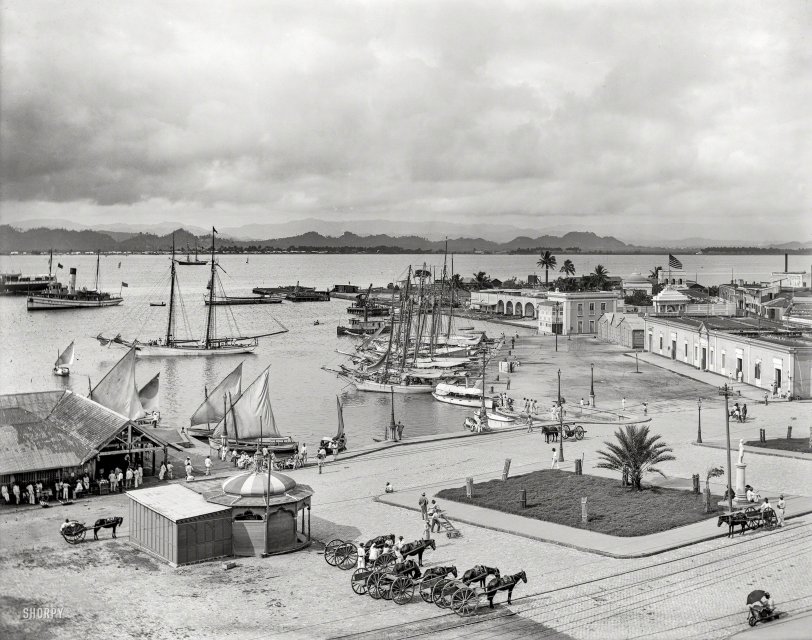


Framed or unframed, desk size to sofa size, printed by us in Arizona and Alabama since 2007. Explore now.
Shorpy is funded by you. Patreon contributors get an ad-free experience.
Learn more.

- Killed by Amtrak
- Back to the Future
- Heckuva remote control!
- Sometimes — Things Go Bump!
- I SEE THE LIGHT
- Union Switch and Signal Company
- Get That Light Out Of My Eyes
- Eggs. Eggs. Eggs. The Egg Man is Here!
- Foreboding caption
- Famous Hollywood faces
- Not just S&P
- re: Those things in the jar
- Up In Smoke
- Medical Smoking
- Quick fix
- A Quink Comment
- If You’re Like Me, Never
- Delivering the News
- U.S.A.
- S&P
- 1940 Zenith radio model 6G601
- Quality goes in before the name goes on!
- Snazzy skirt
- Carbon Arc Lamps
- Illuminate us
- I remember it well
- I can't prove it
- Complicated then, forgotten now
- Bryan-Stevenson
- Skinny is as skinny does
Print Emporium
La Marina: 1903

Puerto Rico circa 1903. "La Marina -- San Juan, P.R." 8x10 inch dry plate glass negative, Detroit Publishing Company. View full size.
Many interesting little scenes
Not only the lateen rig (*), all vessels are remarkable:
The Schooner in the middle of the harbor with the overrlength boom on the main mast, which surpasses the stern by a round six meters (whith the size of the men on the deck as a reference scale).
The Barkentine on the roads in the rear.
The row of Cutters (in the mashing of masts it is difficult to see if there is not a schooner hiding between them), all of which are moored with the stern to the quay.
Before that the small steam boat to the harbor traffic.
But there are a lot more details to discover (in german we call such a picture a "Wimmelbild" - The English translation "Hidden Image" does not even halfway what "Wimmeln" means in German.):
The small kiosk with the horse carriage to the left of it.
The wheelbarrow driver sitting on his cart first makes a small break under his sun umbrella.
In the middle of the square stands a lantern in front of the one-storey building on the right, with the rectangular windows with stucco arches above and the decorative gable in the center. Either the builder of this lantern did not have a lot to handle at the time of the erection, or the lantern was pushed. A sailor who was too long in the harbor? A horse cart? A car? Was there an automobile at all around 1903 in San Juan?
In the foreground is a track in the street pavement. Railroad? Tram? Is this still in use today?
The men who sit at the edge of the walkway and wait for - whatever.
(*)One more comment on the Latin sail: this type of sail was widespread in the Middle Ages up to the 17th century, many square riggers of this time carrying a Latin sail on the last mast. Afterwards, they were pushed out of the gaffel sail quickly (certainly also for the reasons stated by ElViejo). The Gaffel sail itself was then quickly replaced by the even easier to operate and efficient Bermuda- or high sail at the beginning of the 20th century. What we have here is a small detail of the evolution of sails.
Two Still Standing
The building on the right side of frame with the 4 arch openings is now called "Antiguo Arsenal de la Marina Espanola", an art museum. The building next to it with 3 windows on the second floor and two on the lower is also still standing. The buildings closer to the camera are now gone and is now the "US Customs House". The left out of frame is the cruise ship docks. This image is looking south and south of the old city area.
Lateens
The boats in the foreground carry lateen rigs, which originated in the dhows of the Middle East, migrated to Spain with the Moors, and evidently then to Puerto Rico.
Described as "the most dangerous rig ever devised by the wit of man," the lateen requires great skill and many hands to deal with, especially in uncertain weather. In order to tack (change course while going to windward) the crew must lower that large angled boom, move it and the sail to the other side, and raise it again. Once set, however, it is very efficient.
























On Shorpy:
Today’s Top 5